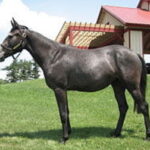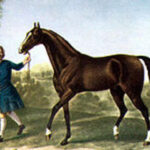A race horse is any horse that competes in speed events on the flat, which means that there are no obstacles, such as jumps or barrels. The speed events—races, steeplechases, barrel racing, pole bending—are some of the most exciting equestrian sports, and racing is the oldest of them all. Race horses are generally Thoroughbreds, though Quarter Horses are famous for running the quarter mile.
Race horses are usually trained at large Thoroughbred farms, often in Kentucky, which is thought of as the home for Thoroughbred horse racing. Many farms have multiple operations, including the training of race horses and the breeding of the same. Once a horse reaches training age, it is moved from the breeding section of the farm and started on a training program.
Although it differs from trainer to trainer, most race horses begin their careers at 1.5 years of age. Some trainers will work with yearlings on flat work, but you have to realize that horses’ legs don’t fuse until they are nearly four years of age, so working with horses that young is dangerous. Since many race horses are worth more than $500,000 before they even enter a competition, it is important for horse trainers to protect their employers’ investments.
Horse racing, more than any other equestrian sport, is a business. Race horses are trained based on a protocol that was developed decades ago by master trainers. The process usually starts on the lunge line in a round pen, as young horses are taught to respond to verbal commands and to respect their trainers’ instructions. Then they are moved into saddle training, which is far more interesting.
Unlike horses trained for pleasure or other equestrian sports, race horses do not need to know how to trot, canter, yield and halt; they simply need to know how to run. They are ridden mostly to the left because that is the direction in which they will run on the track, and gaits other than the gallop are of little importance. In the beginning, trainers want to figure out if a horse is a distance runner or a sprinter.
Different race horses have different ability levels and preferences. For example, some horses will run well only on a dry track, while others don’t mind galloping in the mud. Some race horses can hold back for the first three-quarters of a race, then overtake the leader in the final quarter, while others must keep their pace the entire time. All of these factors must be observed and recorded by the trainer in the first six months of prep.
Race horses that are pegged as distance runners might be worked over long trails in order to build their endurance. They are also given plenty of supplements to help with growth, muscle development and other aspects of their health. Race horses are generally worked once a day and for an average of twenty minutes on the track, depending on the day’s prescribed work-out. Trainers watch while exercise riders (who are sometimes apprentice jockeys) run the horses according to specific instructions.
Most race horses start their racing careers as two-year-olds, and the majority of them are done on the track by the time they are four years old. Some are sold or kept as breeding stock while others are sent to slaughter if they didn’t perform. The goal of a race horse trainer is to break even on every horse he trains, regardless of talent or ability. Sometimes this happens; sometimes it doesn’t.









